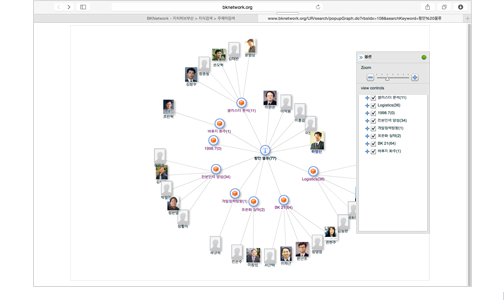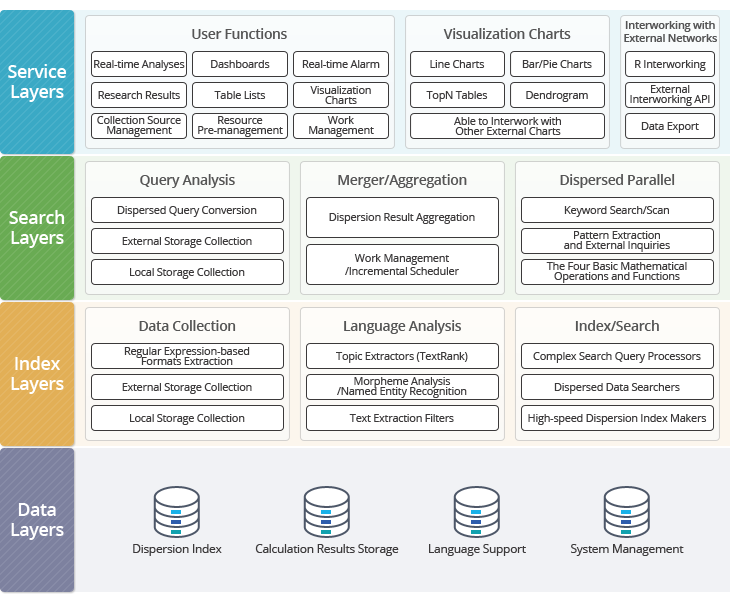Internet development and mobile services make people’s connection structures more dynamic and complex. The connection structures between people become distribution channels of various data and contents with huge effects on decision-making, including our purchasing activities. Saltlux analyzes the structure by extracting semantic social networks from social media, email, and vast corporate documents through knowledge/social network analysis solutions. It also establishes eDiscovery systems, intelligent security analyses, knowledge activity profiling, marketing strategies, experts’ recommendation, and search functions to solve problems by analyzing in-depth knowledge and the mutual influence on networks.

Overview
Social network analysis is a quantitative analysis method to analyze the relationship between objects (all objects including an agent) through graph theory. It consists of various analysis methods according to the analysis target and social network analyses are often paramount. Currently, organizations are trying to discover the new value of knowledge or use it for work/management through distribution analysis and flow of knowledge. They can analyze multiple types of information (documents, email, website, etc.) to configure knowledge networks. Generally, an organization’s knowledge network can provide a basis for user type analysis, knowledge flows, knowledge channel distribution, and knowledge integration within the organization.
Providing integrated knowledge within an organization
Generate integrated knowledge from partial knowledge by department and user.
Provide various knowledge flow information within an organization to communicate between knowledge groups
Information about unspecific groups or certain subjects within networks can promote communication between users or groups.
Minimize work gaps through information analysis between a knowledge holder and a knowledge provider within an organization
Analyses of generating and providing knowledge of users/groups can contribute to the smooth coordination of work between users/groups.
Promote mutual information sharing to improve the overall business capability
Users can easily discover and access information related to work or organization to improve business capability.
Main Features
- Customer Problems
With the diversification and complication of communication channels and cooperative structures, it is difficult to analyze the influence and marketing targets on social media with experts and understand the organization’s cooperative external and internal structures.
- Introduction Effects
Cost-effective social marketing, experts’ recommendations to solve problems, effective knowledge management through character profiling, security and eDiscovery systems establishment through knowledge network analysis, etc.

- Main Functions
Network connection density, strength, analysis of various types of centrality, key figures by subject, proximate figure analyses, related figure analyses by subject, figure profiling by related subject, connection path analyses, and more.

- Built-in Products
STORM, RAINBOW, DISCOVERY, and Interworking
- Major Customers
Busan Metropolitan City Hall, Korean Ministry of National Defense, KT, etc.
Detailed Functions
Knowledge networks are based on a social relationship network and a network of various subjects’ information within an organization. Knowledge/social network analyses provide not only information about knowledge experts and knowledge brokers, but also the analysis results of user types, knowledge flow paths, and knowledge distribution channels. The data sources for knowledge analyses within an organization and analysis methods are as follows:

Knowledge networks configured within an organization enable various analyses and usages according to a certain point of view. Users can easily access or utilize knowledge dispersed within an organization. Therefore, analyses of knowledge networks have the following characteristics.
Knowledge Flow Network Analysis
• Network to show from whom to whom useful knowledge for workflows
• Understanding of business knowledge flow by department and rank
Analyses of knowledge holders and providers
• Analyses of people who not only provide knowledge but also who obtain large amounts of knowledge from others
• Analyses of people hubs to distribute knowledge
Analyses of Potential CoP (Communities of Practice)
• Analyze a group of people who deepens knowledge and expertise in a field through continuous interaction, sharing a passion for certain subjects, group of problems, and other concerns
• CoP analyses are used to discover potential groups through knowledge flow network analyses
• An informal group is formed as a result of the natural knowledge flow, regardless of department or organization
• Enable analyses and definition of a group of people that make up active networks
Analyses of the Shortest Path
• Analyses of the shortest path to reach a person who holds knowledge related to the user
Knowledge Network Use
How to configure a knowledge network using information from an organization and utilize it to form the characteristics of a knowledge network?
Basically, an organization shares various types of work information through its internal email systems. How to apply networks configured through data source analyses, which enables networks like email systems to function?
Email-based networks are configured based on email sending/receiving, while knowledge flow configures knowledge networks by analyzing existing entities on the networks. Here’s how to use it:
Searching for experts
- Find the shortest path to reach experts through surrounding connected networks
- Search for documents held by experts or brokers connected to the user
- Ask brokers or experts for information
Analyses of potential knowledge communities
- Analyze and define a group of people that make up an active network
- Find and define a networking group according to each period while understanding the knowledge flow
Knowledge Flow Network Analyses
- Frequency of sending and receiving certain information
- Appearance frequency of search keywords by each user in each period
- Appearance frequency of search keywords in each period
Knowledge holders and providers
- People who have or provide a large amount of a certain type of knowledge
Finding knowledge brokers
- People hub who distributes a large amount of a certain type of knowledge
Networks within an organization can encounter problems, such as privacy infringement and member supervision. However, it is more beneficial to find various knowledge classes within an organization.
Features
Knowledge networks are based on a social relationship network and a network of various subjects’ information within an organization. Knowledge/social network analyses provide not only information about knowledge experts and knowledge brokers, but also the analysis results of user types, knowledge flow paths, and knowledge distribution channels. The data sources for knowledge analyses within an organization and analysis methods are as follows:
Real-time social network analyses through a social network analysis algorithm
- Analyses of Centrality
- Cluster Analyses
- Analyses of the Shortest Path
SSP (Service Strategy Planning)
- Automated establishment of semantic data-based networks
- Searching for subjects through content indexing
- Automatic generation of networks for searched subjects

Expansion of subject networks through analysis of subject relatedness
- Extraction of related subjects
- Integrated configuration of networks of related subjects
- Statistics for figures about related subjects

HTML5-based Visualization
- Provision of basic visualization
- Easy expansion and changing of a phase
- Provision of standard data interface
- To interwork with other visualization controls



